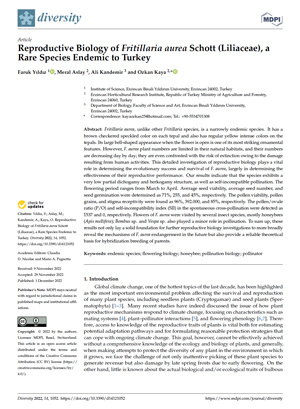NEWS 2022
Reproductive Biology of Fritillaria aurea Schott (Liliaceae), a Rare Species Endemic to Turkey
Faruk YILDIZ1, Meral ASLAY2, Ali KANDEMIR3, Ozkan KAYA2
Diversity 14, 1052 (2022)
https://doi.org/10.3390/d14121052
1Institute of Science, Erzincan Binali Yıldırım University, Erzincan 24002, Turkey
2Erzincan Horticultural Research Institute, Republic of Turkey Ministry of Agriculture and Forestry, Erzincan 24060, Turkey
3 Department of Biology, Faculty of Science and Art, Erzincan Binali Yıldırım University, Erzincan 24002, Turkey
Abstract
Fritillaria aurea, unlike other Fritillaria species, is a narrowly endemic species. It has a brown checkered speckled color on each tepal and also has regular yellow intense colors on the tepals. Its large bell-shaped appearance when the flower is open is one of its most striking ornamental features. However, F. aurea, plant numbers are limited in their natural habitats, and their numbers are decreasing day by day; they are even confronted with the risk of extinction owing to the damage resulting from human activities. This detailed investigation of reproductive biology plays a vital role in determining the evolutionary success and survival of F. aurea, largely in determining the effectiveness of their reproductive performance. Our results indicate that the species exhibits a very low partial dichogamy and herkogamy structure, as well as self-incompatible pollination. The flowering period ranges from March to April. Average seed viability, average seed number, and seed germination were determined as 71%, 255, and 45%, respectively. The pollen viability, pollen grains, and stigma receptivity were found as 96%, 392.000, and 85%, respectively. The pollen/ovule ratio (P/O) and self-incompatibility index (SII) in the spontaneous cross-pollination were detected as 1537 and 0, respectively. Flowers of F. aurea were visited by several insect species, mostly honeybees (Apis mellifera); Bombus sp. and Vespa sp. also played a minor role in pollination. To sum up, these results not only lay a solid foundation for further reproductive biology investigations to more broadly reveal the mechanisms of F. aurea endangerment in the future but also provide a reliable theoretical basis for hybridization breeding of parents.




